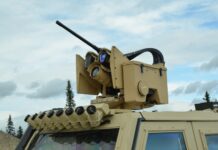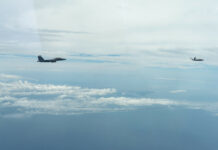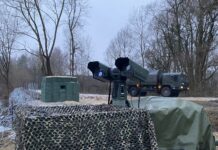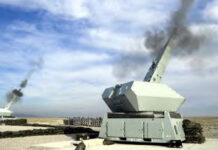The battlefield threat posed by small and medium unmanned aerial vehicles (UAVs), as well as by precision artillery continues to evolve. Both are driving a demand for counter-UAV (C-UAV) and counter-rocket, artillery and mortar (C-RAM) systems, and there is a good degree of overlap between the two. Intense research and development efforts are necessary to devise technologies capable of effectively countering these evolutionary – if not revolutionary – threats.
The threat spectrum today is quite broad and includes medium-sized reconnaissance and strike aircraft, as well as smaller-to-micro-sized UAVs. A portion of these medium-to-small aircraft are purpose built for military applications, but recent conflicts have demonstrated that commercial and consumer-oriented civilian UAVs can be readily reconfigured for combat and combat support missions. The tactical UAV category (often referred to as the ‘Small Tactical UAS’ (STUAS) category in the US) has become especially ubiquitous in recent conflicts, in part because of their low cost, high availability, and relative ease of use. In 2021, the then commander of US Central Command, US Marine Corps (USMC) General Kenneth McKenzie, considered the spread of tactical UAVs as “the most concerning tactical development” since the rise of improvised explosive devices (IEDs) during the Iraq conflict. “I think what we are seeing is the rise of a new component of warfare,” McKenzie said.
His assessment rings true. In the intelligence, surveillance, targeting and reconnaissance (ISTAR) role, small to very small UAVs can approach enemy formations with a relatively low risk of detection, providing information about troop movements or conducting spotting, fire correction, and post-strike battle damage assessment for artillery. Electronic reconnaissance and offensive electronic warfare (EW) are additional missions for UAVs. In the attack role, even commercial-off-the-shelf (COTS) hobbyist small UAVs can be configured to either carry and release ordnance over enemy forces, or to act as loitering munitions (LMs; often referred to as ‘suicide drones’ or ‘kamikaze drones’) carrying explosive payloads all the way to impact. Such LMs can patrol a given sector until sighting a sufficiently valuable target of opportunity. They then effectively transition from a surveillance drone to a precision-guided munition (PGM).

Credit: DARPA
Ukraine – the greatest drone war
Conflicts over the past two decades have highlighted the increased role of UAVs by armed forces worldwide. The dramatic impact of ad hoc reconfigured COTS systems was first fully registered a decade ago during the ISIS/Daesh insurgency in Iraq (although various other irregular forces discovered their utility around the same time). A new intensity has been reached in the ongoing war in Ukraine, where UAVs and artillery feature among the most important weapon systems deployed on the battlefield. Tens of thousands of UAVs have been launched over the past two years, making this a drone war on a scale never seen before. Fixed-wing, global navigation satellite system (GNSS) and inertial navigation system (INS) guided, medium-sized UAVs, such as the Iranian Shahed 131 and 136, strike fixed infrastructure targets, while those equipped with optronic infrared (IR) sensors – such as the Turkish Bayraktar TB2 – can attack mobile military vehicles with guided bombs and missiles. Ukraine’s domestically-developed AQ 400 Kosa UAV has sufficient range to reach Moscow with a 32 kg payload, or shorter distances with a 65 kg payload. Kyiv plans to increase production to 500 units monthly.
In much greater numbers, small UAVs have targeted soldiers in foxholes and trenches, where they were largely shielded from other battlefield threats. Attacking as a single unit and also in swarms, revamped COTS-based quadcopters have also been able to destroy armoured vehicles up to and including main battle tanks (MBT). Many small UAVs are radio remote controlled via a radio frequency (RF) link. This includes so-called first-person view (FPV) UAVs, which effectively function as improvised LMs – the onboard camera provides the operator with a pilot’s eye view, enabling very precise targeting decisions, even flying the aircraft through doorways or into open vehicle hatches. Notably, RF-controlled drone operation does not require a great deal of training; the COTS systems are designed for ease of use, and any nation with a teenage population raised on video games will have a large pool of potential pilots. More sophisticated aircraft, often purpose-built for the military, use GNSS and/or INS to fly pre-programmed reconnaissance or strike missions with minimal direct supervision. Some LMs can display autonomy in targeting, thanks to onboard databases that permit positive identification of legitimate targets. This can allow them to perform their strikes even if the radio link with the control station is jammed.
Escalating threat level
Ukraine aside, leading armed forces are investing heavily in unmanned technology. In addition to performance upgrades such as improved range and endurance, the greatest focus is on using artificial intelligence (AI) to enhance autonomy. Improved AI integration will ultimately have two major operational consequences.
Swarm attacks
Swarm operations are already a reality, but are relatively nascent, and images from Ukraine represent only the beginning. The US Armed Forces have been rather open regarding plans to exponentially enhance the capabilities of autonomous swarms (while various foreign powers are certainly pursuing the same goals more quietly). The US Army has tested swarms composed of dozens of small UAVs during exercises over the past two years. In some experiments, the swarm was able to carry out reconnaissance and attack operations autonomously, following pre-programmed objectives.

Credit: US Army/Aaron Duerk
According to Major General Walter Rugen, currently Director of US Army Aviation, the goal is to enable hierarchical “wolfpacks” of UAVs to operate without direct human supervision, with one aircraft assuming the pack leader role, controlling operations of other units; preselected aircraft would assume control should the leader be neutralised. Such wolfpacks should ultimately be capable of performing sophisticated multi-task operations, with each unit carrying out a specific task – such as reconnaissance, communications relay, suppression/destruction of enemy air defences (including through EW), or direct attack of the primary target – contributing to the overarching mission goal. The other service branches of the US armed forces are conducting similar experiments.
Resilient navigation
Closely related to the issue of autonomy is the quest for redundant and jam-proof navigation systems. Just as PGMs are frequently outfitted with multiple navigation systems such as GNSS, INS, and image-based or terrain-following navigation, future UAVs will likely have redundancy which includes interference-proof navigation options. Similarly, future UAVs will require multiple targeting systems to deal with various passive or active countermeasures. Targeting options could include optical and infrared, laser, or – depending on the size of the UAV – radar. Onboard defensive EW systems to minimise the impact of jamming, preserve communications links, and interfere with enemy targeting would further enhance UAV survival and increase the likelihood of mission completion.
Precision and saturation artillery
Using the chessboard analogy of warfare, UAVs have emerged as the knight on the modern battlefield, capable of manoeuvring in a unique manner, and overcoming obstacles in the process. As the war in Ukraine is demonstrating, artillery remains the queen of the battlefield, striking straight, but over long distances. Whether engaging static or mobile targets, military or infrastructure, tube and rocket artillery has demonstrated the conflict’s deadliest sustained effects. Here, too, major efforts to upgrade range, precision and lethality are underway in all major armed forces. Rockets, artillery and mortars (RAM) constitute a major threat to both static installations and manoeuvre forces, with the threat potential increasing in the coming decades. As such, the imperative to improve and field C-RAM systems is increasing.
C-UAV and C-RAM requirements
Traditional missile-based air-defence systems are well suited to downing larger to medium-sized, sophisticated military UAVs and LMs on the larger side of the spectrum, such as the Shahed family. However, they are not a viable option for C-UAV operations against small UAV threats. Even when the latter can be detected within the engagement zone of very short-range air defence/ short-range air defence (VSHORAD/SHORAD) systems, their ability to be employed in large numbers would quickly drain (V)SHORAD magazines, leaving the protected units vulnerable to attack by more sophisticated aircraft or missiles. The asymmetry of cost also makes traditional air defences a financially unsustainable solution against such threats. To get a sense of the extent of this asymmetry, in May 2023, CBS News reported that a single FIM-92 Stinger family missile costs over USD 400,000 – by contrast a typical off-the-shelf small UAV such as a DJI quadcopter costs only a few hundred dollars.
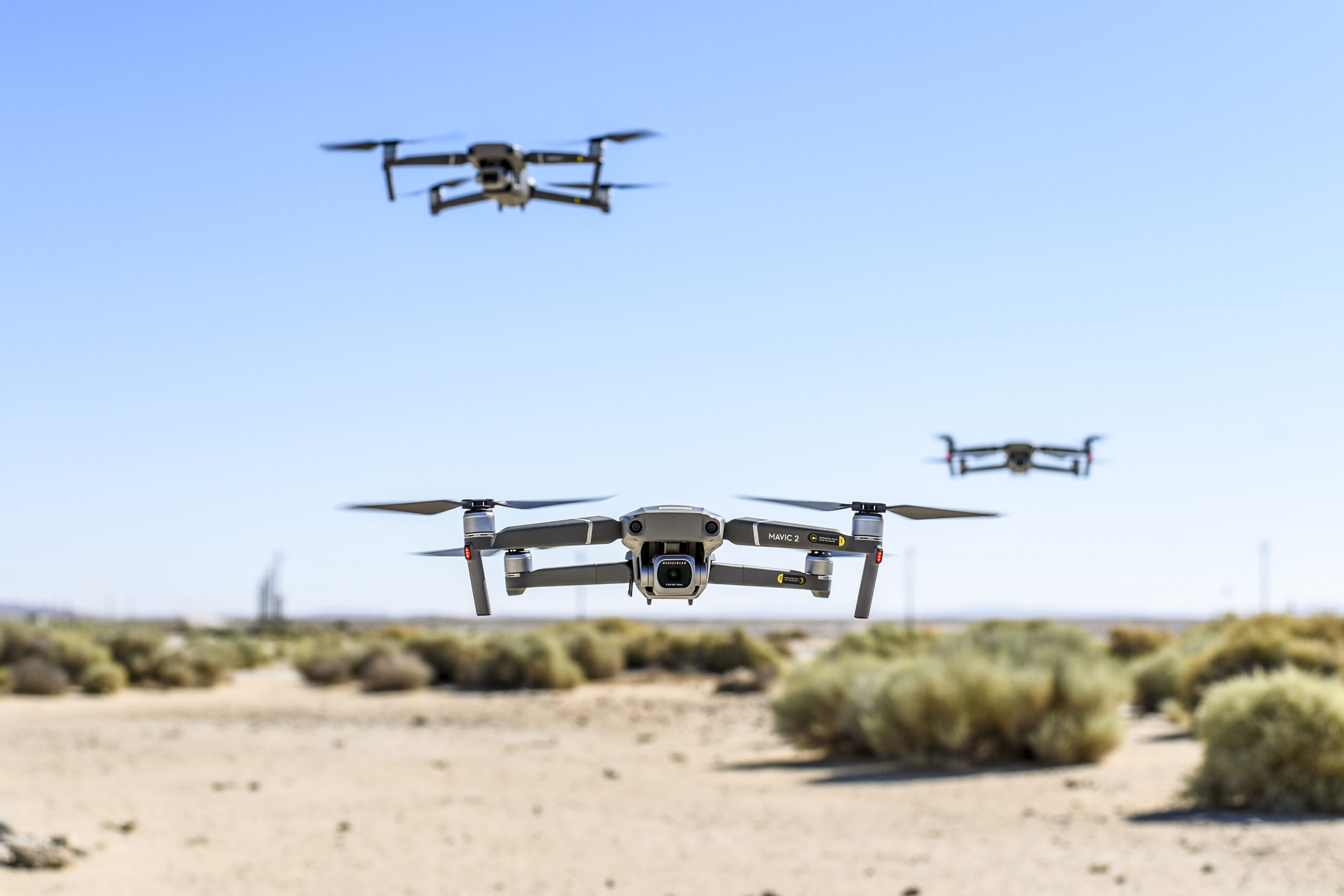
Credit: USAF
To date, RF jamming continues to be the most widespread (and arguably most effective) weapon against small UAVs. RF interference works by disrupting the aircraft’s navigation and control systems, either by blocking reception of the command signal from the control station, or by blocking satellite navigation frequencies to disrupt GNSS guidance. Depending on the strength of the jamming system, effects can be scaled both in intensity and in terms of the width and depth of the targeted airspace. Both sides in Ukraine deploy extensive jamming to defend their own positions from enemy aircraft, and to suppress enemy UAV capabilities ahead of offensive operations. Powerful electronic warfare systems can be mounted in fixed positions or vehicle-mounted for easy relocation. Lower-echelon tactical units are outfitted with portable jammers, while tanks and other combat vehicles have been photographed with jammers atop their turrets.
However, EW-based countermeasures have some weaknesses. Frequency hopping can often be a simple and effective means to circumvent RF jamming. Also, as Ukrainian strikes on Russian EW sites have demonstrated, the jammer’s signal can be triangulated, allowing them to be located and targeted by artillery, or air-launched bomb or missile strikes.
Increased autonomy and introduction of redundant navigation systems is expected to diminish the impact of RF jamming in the future, but this will not be an absolute. Some drones will continue to rely on RF datalinks for remote control, for receiving tasking updates, or for relaying situational awareness data back to their operator. GNSS will continue to be an important navigational tool, even when additional interference-proof navigational systems become more widespread.
Jamming may still negatively impact UAV effectiveness even when it does not fully disable vehicle control or navigation. EW technology is expected to continue to advance, improving signal strength, range and effectiveness as well as using smaller portions of the electromagnetic spectrum in order to minimise collateral impact on friendly systems. The Pentagon plans to routinely field jamming capabilities at lower echelons, specifically at the platoon level, and is already experimenting with EW systems mounted on light infantry vehicles such as the USMC’s MRZR. Other armed forces are pursuing a similar course.
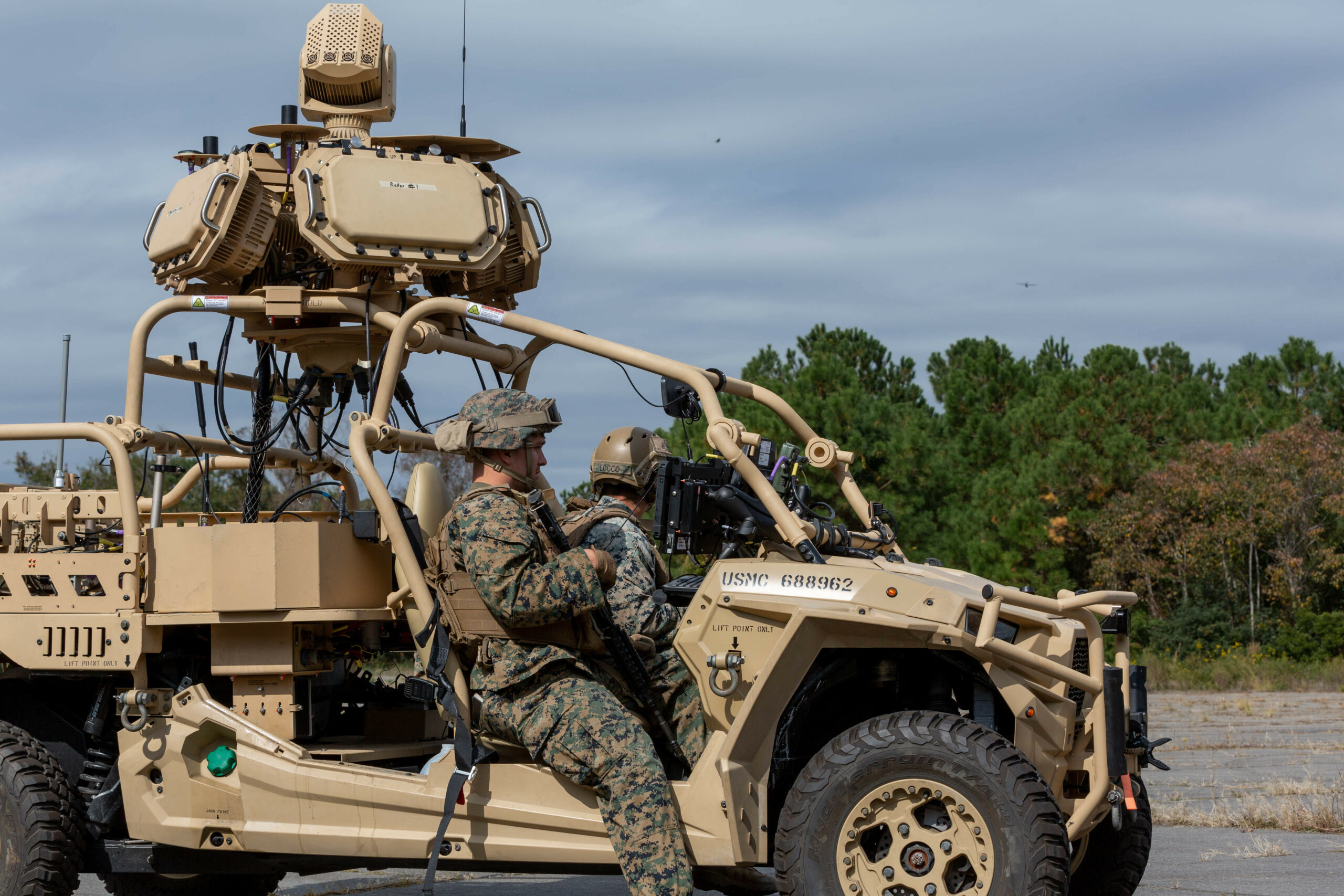
Credit: USMC
Improved jamming alone cannot counter balance the expected enhancement of tactical UAV capabilities and operating concepts. Additional kinetic technologies are being actively pursued. Some of these measures may also be able to protect ground forces and installations from rocket, artillery and mortar (RAM) attack. Such C-RAM systems can have a large degree of capability overlap with the C-UAV role, making systems capable of undertaking both missions an attractive proposal.
High-energy laser systems
One major avenue of research for C-UAV and C-RAM is focussed on high-energy lasers (HEL). Several advantages frequently cited regarding HELs, and indeed other directed energy weapons (DEWs) is the so-called ‘unlimited magazine’. Unlike missile launchers or air-defence guns, a laser can – within reasonable limits – operate as long as the energy supply is maintained.
Operating costs are also significantly lower than those of kinetic weapon systems. Here again the US Armed Forces have been making systematic progress toward testing more powerful vehicle-mounted laser systems. In October 2023, the US Army awarded Lockheed Martin a contract to develop and deliver prototypes of the Indirect Fire Protection Capability-High Energy Laser (IFPC-HEL). According to the Army, the truck-mounted objective weapon system is designed to protect fixed and semi-fixed sites from UAVs, cruise missiles, RAM threats, as well as “[manned] rotary and fixed-wing threats”. The prototypes are to be delivered by 2025.
To protect the manoeuvre force, the US Army has been pursuing DEWs under the Directed Energy Manoeuvre Short Range Air Defense (DE M-SHORAD) programme. Four Raytheon-designed prototype systems mounted on Styker armoured vehicles were delivered to the Army in January 2023 to equip a platoon-sized test and evaluation unit. The 50 kW laser weapon is designed to defeat UAVs up to size class 3 (600 kg), as well as RAM threats. The user assessment phase was slated to continue through early 2024. Intermittent reports stated that the system was proving effective against UAVs but that “challenges remain” regarding the C-RAM mission. Smaller 10 kW and 20 kW systems are also being evaluated on pallets and light vehicles, but their effectiveness is limited to smaller UAV classes.

Credit: US Army
There are various suggestions regarding how a HEL could most effectively neutralise a UAV or artillery projectile with current tests demonstrating success in disabling the motor of smaller UAVs. The simplest approach would be to burn out or blind the targeting or homing system of the aircraft or projectile. This would work best against a remote-controlled or autonomous UAV equipped with optical sensors. However, this would do little to divert an artillery round from its ballistic flight path. It is important to consider that the ultimate goal is to develop considerably more powerful tactical lasers in the 1 MW range or higher. The higher the energy output, the faster any single target can be defeated or disabled. Optronics and control systems are also being improved to improve the speed with which a target can be acquired, as well as the ability to keep the beam focused on one particular spot of the target; the latter will be particularly decisive in disabling RAM projectiles, which must be accomplished by burning through the casing to reach and detonate or deflagrate the warhead.
Despite ongoing developments, several questions still remain regarding laser utility for C-UAV and C-RAM. Difficulties relate to the need to project sufficient energy onto the target and keep the beam focused long enough to disable the UAV or incoming ordnance. While lasers currently being tested are considered potentially strong enough to down an unmanned aircraft or burn through the casing of an artillery shell, laser weapons still face challenges. Beam integrity deteriorates with range, since the beam gets wider as it gets further from the source, and can also be degraded by inclement atmospheric conditions. These factors can therefore limit the effective range of a HEL. The US Department of Defense cites an effective range of approximately 1 km for today’s DE weapon systems. However, battlefield conditions – including smoke from burning vehicles, detonating ordnance, as well as deployment of obscurants – can interfere with beam integrity even at shorter ranges.
Finally, the manoeuvrability of UAVs and the speed of rocket and artillery projectiles pose significant challenges to keeping a laser beam on target for more than a few seconds – especially when operating in an environment with many line-of-sight blockers present. Even if future HELs are powerful enough to disable a target within such a short timeframe, the need to focus on each target for several seconds makes lasers vulnerable to swarm attacks. If, for example, a laser can engage a rocket 30 seconds before impact, and requires only five seconds to target and destroy each warhead, an enemy could overwhelm the C-RAM system by launching at least seven projectiles simultaneously. While tactical HELs could ultimately contribute to the C-UAV and C-RAM operations, it seems unlikely that they alone will be the most effective solution.
Microwave weapons
Another promising C-UAV concept is deployment of high-power microwave (HPM) weapons. HPM energy can destroy sensitive onboard electronic components, disabling navigation and control systems and forcing drones to the ground. A single nanosecond-long pulse can be sufficient to down entire drone swarms simultaneously. As with lasers, the US military considers this a priority technology. “This is going to provide us the best opportunity to get after larger swarms that come your way because essentially, you’re looking (at) technology, that if it continues to move, can potentially fry the electronics in these UASs,” said US Army Maj. Gen. Sean Gainey, head of the Joint C-UAS Office (JCO), during the August 2022 Space and Missile Defense Symposium in Huntsville, Alabama.
Among other initiatives, there is a second IFPC leg, the Indirect Fire Protection Capability-High Power Microwave (IFPC-HPM), which is focused on developing and testing an HPM weapon. In January 2023, the technology company Epirus received a contract from the Army’s Rapid Capabilities and Critical Technologies Office (RCCTO) to deliver prototypes of their Leonidas HPM system. The award followed several rounds of system demonstration, where Leonidas was reported to have outperformed competitors in defeating drone swarms and other electronic systems. The first prototype was delivered on 1 November 2023. According to Epirus, Leonidas’ digitally beamformed antenna can alternately create a focused beam that disables a single target within a crowded airspace.
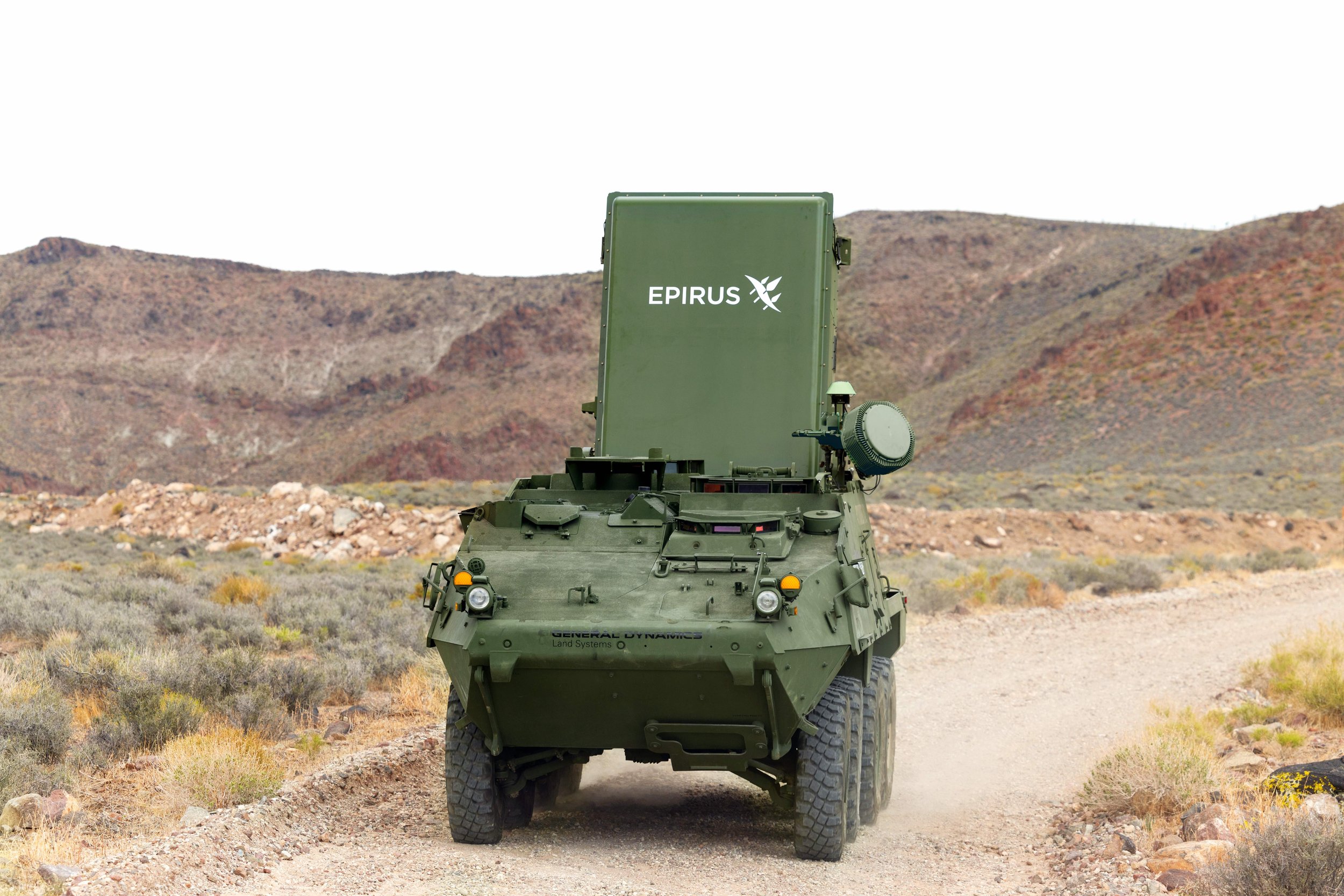
Credit: Epirus
Epirus’ CEO, Leigh Madden, added that the system’s software can process input from Blue Force Trackers and IFF transponders to ensure that HPM pulses are directed around friendly forces. In October 2022, Epirus and General Dynamics Land Systems unveiled a mobile variant of Leonidas mounted on a Stryker armoured vehicle, referred to as ‘Leonidas Mobile’. The Army hopes to transition IFPC-HPM to an acquisition programme of record in 2025, following prototype evaluation of the weapon system.
Other HPM systems are currently being evaluated. These include the Tactical High-power Operational Responder (THOR) technology demonstrator developed by the US Air Force Research Laboratory (AFRL) specifically for the C-UAV role. The system can be fully stowed within a 6 m ISO container, and in its ready state the steerable dish antenna of the microwave effector is visible atop the container roof. The system can be air-transported by a C-130 transport aircraft and set up and made operational by two people within 3 hours; its energy is drawn from a grid. It has been tested against single UAVs since 2021, and eliminated an entire drone swarm during the first-of-its-kind test in spring of 2023. “THOR was exceptionally effective at disabling the swarm with its wide beam, high peak powers, and fast-moving gimbal to track and disable the targets,” said programme manager Adrian Lucero from the AFRL Directed Energy Directorate. Additional testing of THOR in the base-security role is planned for 2024.
However, the Air Force has already begun transitioning the technology to the private sector. In February 2022, the Air Force awarded Leidos Inc. a contract to develop “a next-generation counter-electronic weapon system”. According to AFRL, it will build directly on the technology demonstrated by THOR, but will add enhanced capability, reliability and manufacturing readiness. Staying with the Nordic theme, the new HPM weapon system is designated ‘Mjolnir’ after Thor’s hammer. “Because THOR was so successful, we wanted to keep the new system’s name in the family […] Mjölnir will focus on creating a detailed blueprint for all future C-UAV HPM systems with enhanced range and technology for detecting and tracking UASs,” said Lucero.
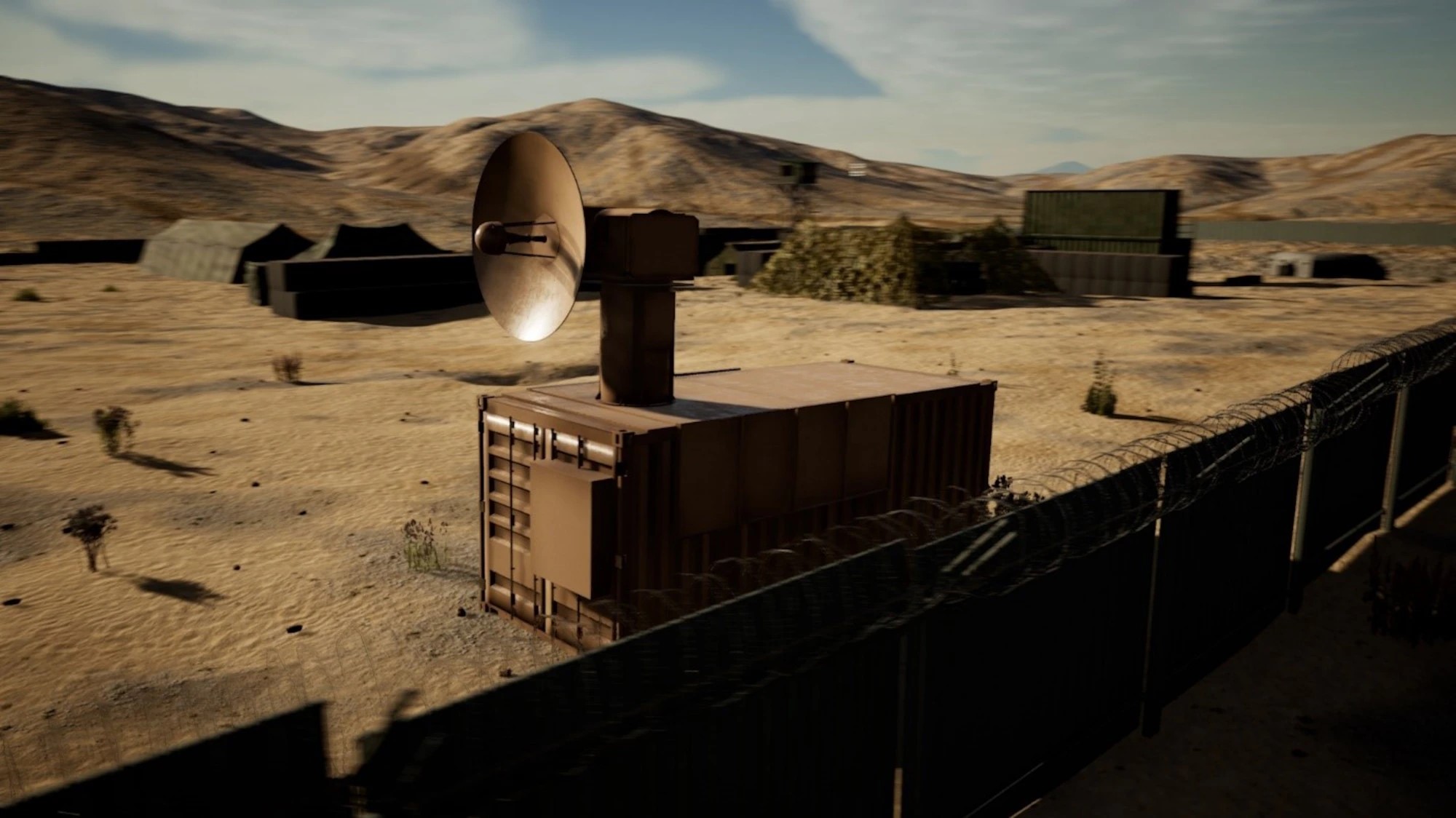
Credit: AFRL
HPMs also have the potential to be used for the C-RAM mission, where the defeat mechanism would involve disabling precision guidance systems or possibly even the fuzes used by their targets. This would likely be (at least initially) restricted to fixed or semi-fixed installations, given the current sizes of sufficiently-powerful systems. A study released by the Air Force Research Laboratory in July 2021 – titled Directed Energy Futures 2060 – postulated that DE weapons, including HPMs and HELs, could ultimately form a de facto “force field” around high value targets, repelling not only UAVs, but also RAM threats and missiles.
Kinetic solutions
In August 2022, the JCO’s Gen Gainey stated that the US military would need to start “leaning toward” kinetic options as UAVs become increasingly autonomous and less reliant on communications links. “If you’re focused only on an EW system and they’ve evolved past whatever you’re denying with that EW or non-kinetic capability, we got that kinetic effector that can then provide that capability,” Gainey said during a speech at the Space and Missile Defense Symposium in Huntsville, Alabama.
Turret-mounted 30 mm guns firing airburst munitions using proximity fuses have shown the greatest promise so far in testing. Northrop Grumman is developing a family of advanced programmable air-burst munitions (PABM) for chain guns. These include guided medium-calibre 30 mm and 50 mm munitions with in-flight trajectory guidance, assisted by sophisticated target identification algorithms on the platform side, promising enhanced effectiveness against drone swarms. For defence of infrastructure targets, a modified Phalanx system would seem suitable against UAVs of most size classes. Machine guns remain an option of last resort, though Ukrainian soldiers have used truck-mounted automatic weapons – including World War I Maxim guns – to good effect against small UAVs. However, they are not an ideal solution.
Armed interceptor UAVs
Today, UAVs seem well positioned to serve as armed interceptors. Over the past decade or more, some quadcopters have been armed with nets, shotgun shells, and other ordnance suited to disabling hostile quadcopters. Kamikaze-type interceptors have also been fielded, and those presented so far have included both hit-to-kill and warhead-equipped models.
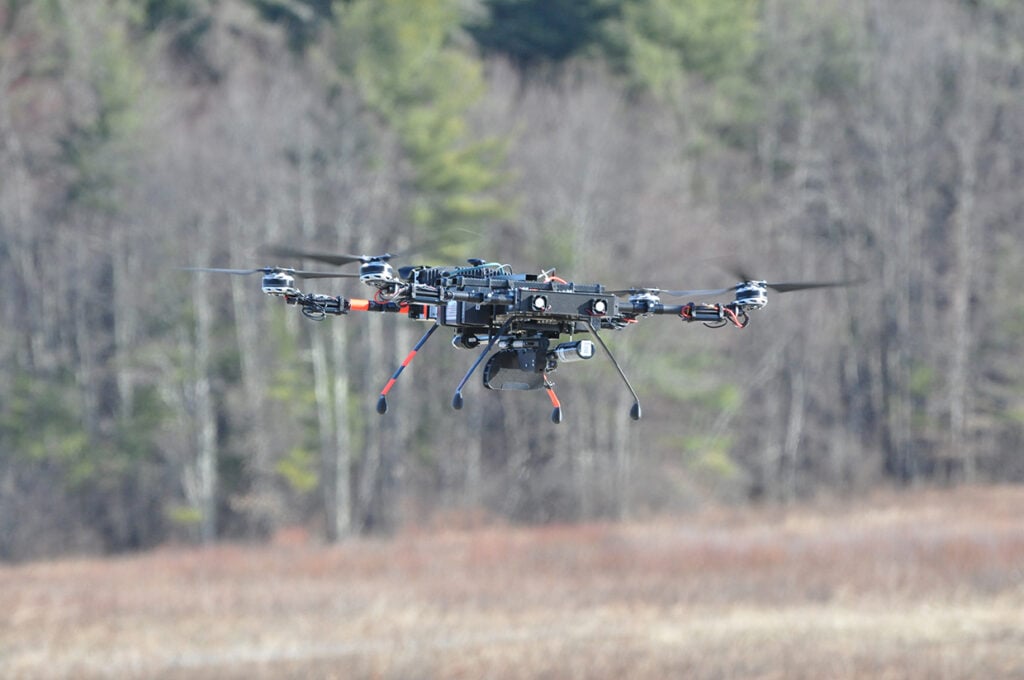
Credit: Aurora Flight Sciences
Recently presented systems include the Modular Intercept Drone Avionics Set (MIDAS) quadcopter developed by Aurora Flight Sciences and Anduril Industries’ Roadrunner-M. The MIDAS is equipped with modular rails capable of accommodating various payloads. These include a projectile weapon capable of firing multiple rounds, potentially allowing the defeat of up to 16 small UAVs per mission. Target cuing utilises ground-based radar, as well as onboard optical sensors. The modularity of the system permits upgrades necessary to counter future threat developments. By contrast, the manoeuvrable, jet-powered Roadrunner-M is a ‘kamikaze-type’ drone, which flies at high-subsonic speed and is armed with an explosive warhead, initiated by what appears to be a laser proximity fuze. It intercepts targets by flying close enough to them for the warhead to activate. Anduril states that it would be especially suited to defeating Shahed-type UAVs, as well as larger systems, including manned aircraft. US DoD budget documents for 2024 reveal that the US Special Operations Command (SOCOM) is acquiring the system.
In a similar vein, the tube-launched Coyote UAV, developed by RTX, has been proposed as another ‘kamikaze-type’ C-UAV solution. The vehicle which can be deployed from the ground, air or sea, and is equipped with an active radar seeker and high-explosive warhead, enabling it to identify and defeat hostile UAVs. The Coyote has demonstrated its ability to operate in a coordinated swarm of up to 24 aircraft, giving the system the potential to directly attack enemy UAV swarms in large-scale ‘swarm-on-swarm’ aerial engagements. The Coyote can also be equipped with various payloads including an EW suite or a high-power microwave emitter, permitting non-kinetic engagement of unmanned threats.

Credit: US Army
Lockheed Martin has developed another tube-launched UAV, designated MORFIUS, which is equipped with what appears to be an IR seeker, as well as an HPM payload designed to counter UAV swarms. MORFIUS is intended to fly relatively close to its targets, before engaging them with its HPM payload, which, according to Lockheed Martin, is capable of projecting a Gigawatt of microwave power. A particular advantage of UAV-mounted HPMs is their ability to engage enemy swarms well in advance of friendly forces, before the hostile drones are positioned to initiate their own attack.
No silver bullets
In June 2024, the JCO is due to host its next technology experiment at White Sands Missile Range, New Mexico. The exercise scenario is built around an adversary’s attempt to overwhelm US C-UAV defences through massed attacks by swarms of up to 50 UAVs, making it the largest scale demonstration of its kind. Given the scale of the attack, the exercise is expected to rely heavily on EW systems, said Col. Michael Parent, JCO acquisition chief who added, “Let’s face it, kinetic is challenged because we talked about [defeating] 20 to 50 [UAVs].”
However, as noted earlier, drone autonomy can limit the utility of EW-based C-UAV systems. This will become more acute in the coming years as UAVs become increasingly autonomous and are shielded against electronic attack, including hardening of systems against microwave energy. In the words of Gen. Rainey, “There is no silver bullet. No one system is going to be able to defeat all these threats.” As UAVs become more sophisticated, future defence efforts must rely on an integrated system of systems. Just as air and missile defence is now layered, an effective C-UAV solution requires multiple overlapping capabilities in order to avoid gaps in coverage. This is the approach the US Armed Forces are currently pursuing. HPM weapons such as THOR and Mjolnir are, for example, expressly referred to as complementary to laser, kinetic and explosive countermeasures. This approach will likely be pursued by any nation capable of financing a full-spectrum C-UAV arsenal.
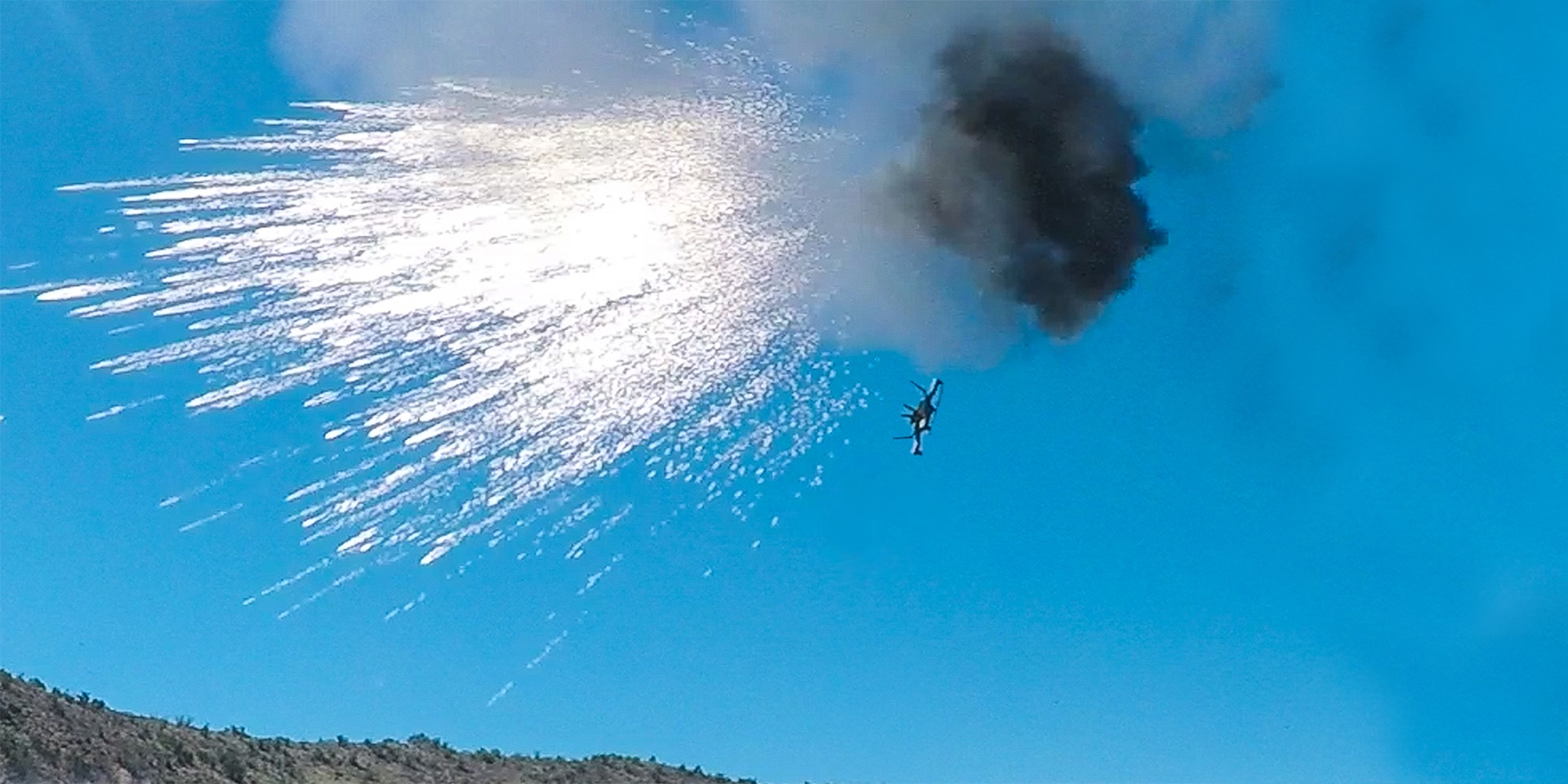
Credit: Northrop Grumman
To be clear, jamming and microwave weapons capable of covering broader sectors of airspace and engaging large numbers of enemy systems simultaneously will be vital elements of future C-UAV arsenals. UAVs that do not succumb to this first line of defence must then be engaged directly. A broad spectrum of mutually supportive weapon systems including laser, vehicle-mounted and man-portable projectile weapons, as well as airborne systems, must be included. If fielded in sufficient quantity and optimally deployed, such a layered mesh could form a tight shield, minimising the chance of enemy UAVs slipping through the gaps and inflicting strikes on friendly forces.
In any case, the C-UAV mission currently seems somewhat more feasible than an effective C-RAM solution, in large part due to the greater range of effector options. Even if the guidance system of PGMs could be neutralised by jamming, laser dazzling/optical ‘burn-out’, or microwaves, the inertia of various munitions in the final stages of a ballistic flight path (such as artillery shells) may ultimately require kinetic solutions to ensure they are successfully stopped. These will need to be deployed with sufficiently deep magazines and extended engagement ranges in order to protect against intensive and prolonged artillery barrages. As for the AFRL’s prediction of a “force field” style umbrella repelling RAM threats in the coming decades, many experts believe this will remain confined to the realm of science fiction for years to come.
Sidney E. Dean





